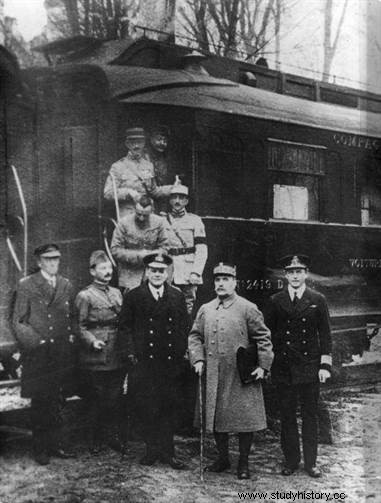 The Armistice of November 11, 1918 ended the First World War. Signed in Rethondes in a wagon belonging to General Foch, it signals the end of the fighting between the Allies and Germany, which has been going on for four years. Despite the memory of the dead, the ceasefire is welcomed in France by an outpouring of joy. It ends the battle on the western front, from Switzerland to the Netherlands. The main clauses of the agreement provide for the delivery of military equipment, the evacuation of Alsace-Lorraine and the left bank of the Rhine; they prepare for the Paris Peace Conference (January 1919) and the signing of the Treaty of Versailles on June 28, 1919. November 11 will officially become a day of national commemoration in 1922 to celebrate the memory of veterans.
The Armistice of November 11, 1918 ended the First World War. Signed in Rethondes in a wagon belonging to General Foch, it signals the end of the fighting between the Allies and Germany, which has been going on for four years. Despite the memory of the dead, the ceasefire is welcomed in France by an outpouring of joy. It ends the battle on the western front, from Switzerland to the Netherlands. The main clauses of the agreement provide for the delivery of military equipment, the evacuation of Alsace-Lorraine and the left bank of the Rhine; they prepare for the Paris Peace Conference (January 1919) and the signing of the Treaty of Versailles on June 28, 1919. November 11 will officially become a day of national commemoration in 1922 to celebrate the memory of veterans.
Before the armistice of November 11, 1918, four years of war
The armistice of November 11, 1918 put an end to a long-lasting world war that had begun 4 years earlier. The triggering event was the Sarajevo bombing of June 28, 1914. Serbian student Gravilo Princip , assassinates the heir to the Austro-Hungarian Empire:Archduke Francis Ferdinand and his wife. An unfortunate consequence:Austria then declared war on Serbia, accused of having organized this attack. Claiming a French air attack, Germany declared war on France on August 3 and invaded Belgium the next day. It's October 11 that France declare war on Austria-Hungary.
The alliance system is structured as follows:on one side there is the Triple-Entente created in 1907 comprising France, the United Kingdom and Russia and on the other the Triple-Alliance , created in 1882 integrating Austria Hungary, Germany and Italy which will change sides in 1915.
As a reminder, the First World War is divided into three phases:
- The War of Movement (1914) where the victorious Battle of the Marne was held on September 6-11.
- Trench or positional warfare (1915-1917):the soldiers settled in the trenches and made massive use of artillery. The Battle of Verdun caused the death of 500,000 men.
- American aid then the resumption of mobile warfare in 1918:the United States intervened in April 1917.
March 1918:the course of the war is racing
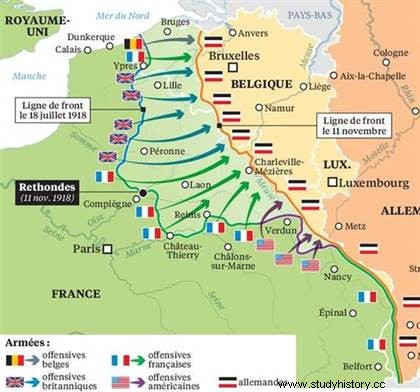 While the front in the west had remained relatively frozen for four years, the war in the east marks a turning point in March 1918 when Bolshevik Russia signed peace with the Central Powers (Germany, Austria-Hungary, Ottomans) in Brest-Litvosk, at the cost of colossal territorial losses.
While the front in the west had remained relatively frozen for four years, the war in the east marks a turning point in March 1918 when Bolshevik Russia signed peace with the Central Powers (Germany, Austria-Hungary, Ottomans) in Brest-Litvosk, at the cost of colossal territorial losses.
From then on, the German generals resumed the offensive in the west by relaunching the war of movement. A breakthrough in the region of Saint-Quentin at the end of March beginning of April 1918 sinks the English army. The German generals hoped to take a decisive advantage before the American commitment , which had entered the war the previous year, was effective on the front. The German advance was nevertheless stopped by the Franco-British in Amiens.
The allied armies, placed under the command-in-chief of General Foch repel a German offensive in Flanders in April and in the Aisne in June. A final offensive – called peace – was repelled in July 1918 in Champagne. It was then the turn of the allies to take the initiative in the Marne and in Amiens with the support of the Americans and a significant commitment of tanks . Success combined with a lasting psychological effect. The fate of the weapons finally gives a glimpse of a way out of the conflict.
Towards the end of the nightmare?
In mid-August 1918, German military leaders seemed to no longer believe in the possibility of victory but refused to take responsibility for opening peace talks with the Germans. 'enemy. Subjected to the pressure of its multiple nationalities and on the verge of explosion, Austria-Hungary launched an appeal for peace which was rejected by the allies. In the Balkans and in the East, the Ottoman Empire collapses.
At the end of September 1918, the Allied troops launched a general offensive which forced the Germans to withdraw to the Meuse. In mid-October an attempt to negotiate peace with the more conciliatory Americans (the famous 14 points of Wilson) failed on the precondition of the abdication of the German Kaiser Wilhelm II. From then on, the French made known the military conditions that they wished to see imposed on Germany under the conditions of an armistice , to make it impossible to resume fighting if peace negotiations fail.
While the German General Staff drags out armistice talks, the Austro-Hungarian army in full disarray lays down its arms on November 3 after an Italian victory in Veneto . In Germany, now isolated, the mutiny of the navy and an insurrectionary situation in many cities forced the German government to start negotiations for an armistice.
Armistice of November 11, 1918
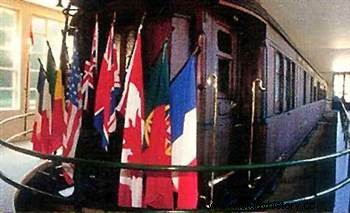 On November 8, Generalissimo Foch presents to Secretary of State Erzberger, President of the German delegation, the conditions for armistice. The German army must withdraw behind the left bank of the Rhine, deliver its heavy weapons, its war fleet and its trains, and free the Allied prisoners. The abdication and flight of William II precipitates the negotiations.
On November 8, Generalissimo Foch presents to Secretary of State Erzberger, President of the German delegation, the conditions for armistice. The German army must withdraw behind the left bank of the Rhine, deliver its heavy weapons, its war fleet and its trains, and free the Allied prisoners. The abdication and flight of William II precipitates the negotiations.
Based on President Wilson's 14 points, whose objective is to sustain peace, the German plenipotentiaries sign the armistice with the allies at dawn , in Marshal Foch's wagon parked in a clearing in Rethondes in the forest of Compiègne. The ceasefire must come into force at 11 a.m. and Foch has obtained the maintenance of most of the clauses demanded by the French:recovery of Alsace-Lorraine, demobilization of the German army and navy, and occupation of the Rhineland.
The news of this end to hostilities is greeted with immense relief, especially in France where the human losses and material damage were considerable, the eastern quarter of the country being reduced to ruins.
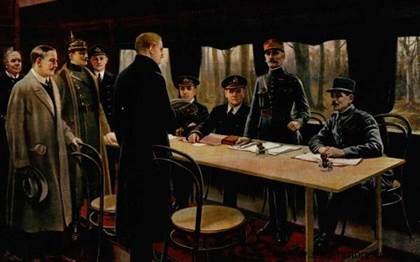 Across Europe there are nearly 10 million deaths – including 1.5 million for France – not counting the many wounded and missing. In many parts of the world, especially in Eastern Europe and the Balkans, hostilities would continue for many years after the November 11 armistice and the ensuing Versailles peace treaty in June 1919. “It will be more difficult to win the peace than to win the war”, said a lucid Georges Clemenceau despite the victory...
Across Europe there are nearly 10 million deaths – including 1.5 million for France – not counting the many wounded and missing. In many parts of the world, especially in Eastern Europe and the Balkans, hostilities would continue for many years after the November 11 armistice and the ensuing Versailles peace treaty in June 1919. “It will be more difficult to win the peace than to win the war”, said a lucid Georges Clemenceau despite the victory...
November 11, Remembrance Day
November 11, 1920 celebrates the first tribute to the unknown soldier at the Arc de Triomphe. The first article of the law of November 2 stipulates that "The honors of the Pantheon will be returned to the remains of one of the unidentified soldiers who died in the field of honor during the 1914-1918 war. The transfer of the remains of this soldier will be solemnly made on November 11, 1920 ".
To this end, on November 10, Auguste Thin , a 21-year-old and private second class in the 132nd Infantry Regiment has been chosen to choose one of eight unmarked coffins containing the remains of soldiers killed during the war. By adding the numbers of his regiment (1+2+3), his choice fell on the sixth coffin. The other seven were buried in the Faubourg Pavé cemetery in Verdun. The Entombment of the unknown soldier under the vault of the Arc de Triomphe took place on January 28, 1921. The following inscription can be read on the slab:"Here rests a French soldier who died for his country 1914-1918 ". 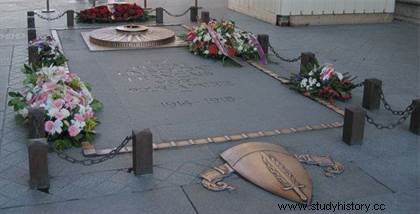 It was 1922 that November 11 becomes the day of national commemoration. The following year, the flame of remembrance will be lit by André Maginot, Minister of War and Pensions. In all the municipalities of France will be erected a monument to the dead accompanied by a ceremony organized by the city. Each year, the flame of remembrance is rekindled by the President of the Republic. Note that November 11 is also a public holiday for Belgium and Canada.
It was 1922 that November 11 becomes the day of national commemoration. The following year, the flame of remembrance will be lit by André Maginot, Minister of War and Pensions. In all the municipalities of France will be erected a monument to the dead accompanied by a ceremony organized by the city. Each year, the flame of remembrance is rekindled by the President of the Republic. Note that November 11 is also a public holiday for Belgium and Canada.
To go further
- The end of the nightmare:November 11, 1918, by Rémy Cazals. Editions Privat, September 2018.
- The armistice of Rethondes:(November 11, 1918), by Pierre Renouvin. NRF, 2006.
- November 11, 1918, by Marc Ferro. Perrin, October 2008.
